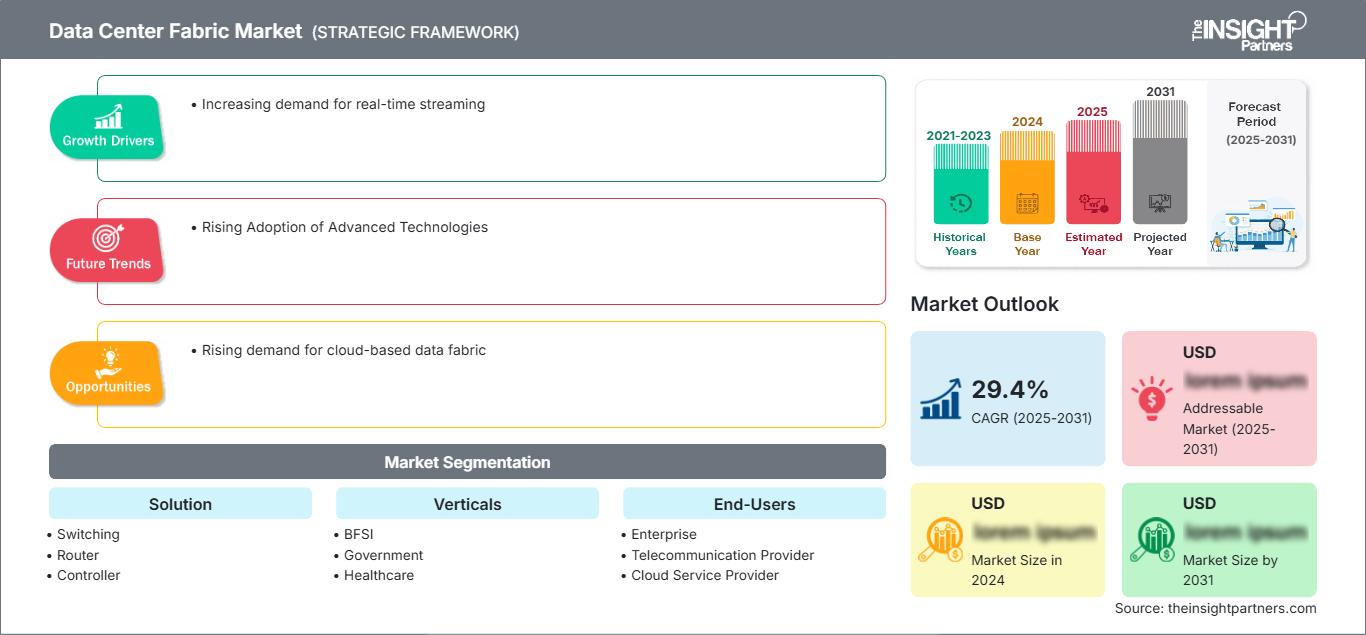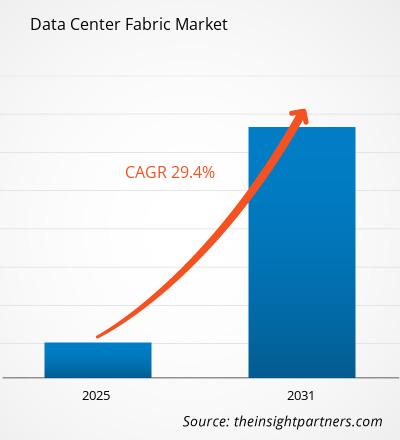Der Markt für Data-Center-Fabric wird bis 2031 voraussichtlich ein Volumen von 196,45 Milliarden US-Dollar erreichen. Für den Zeitraum 2025–2031 wird ein jährliches Wachstum von 17,2 % erwartet. Die steigende Nachfrage nach Cloud-basierter Data-Fabric dürfte weiterhin ein wichtiger Markttrend bleiben.
Marktanalyse für Rechenzentrumsinfrastruktur
- Faktoren wie die zunehmende Nutzung von Cloud Computing, Big-Data-Tools und mehrstufigen Rechenzentrumsarchitekturen spielen weiterhin eine bedeutende Rolle für das Wachstum des Marktes.
- Darüber hinaus können mit der Einführung von Data-Center-Fabric-Lösungen die Daten und Informationen der Unternehmen auf fortschrittlichere und sicherere Weise verarbeitet werden, was wiederum die Endnutzer dazu anregt, diese fortschrittlichen Lösungen zu übernehmen.
- Händler betreiben Computertechnik, Big-Data-Analysen und Rechenzentrumsvirtualisierung. Der Einsatz dieser neuen Technologien verleiht der Entwicklung und Verbreitung dieser noch jungen Branche zusätzliche Impulse.
Marktübersicht für Rechenzentrumsinfrastruktur
- Die Data Center Fabric definiert, wie die Rechen-, Netzwerk- und Softwarekomponenten eines Rechenzentrums zusammenarbeiten, um eine ganzheitliche Einheit zu bilden, die letztendlich IT-Dienstleistungen für ihre Kunden erbringt.
- Da dadurch die Netzwerkarchitektur effektiv vereinfacht wird, werden die Entfernungen zwischen den Endpunkten innerhalb des Rechenzentrums drastisch reduziert, was höchste Effizienz und sehr geringe Latenzzeiten ermöglicht. Moderne Rechenzentrums-Fabrics basieren typischerweise auf einer zweistufigen Spine-Leaf-Architektur (oder einem sogenannten Clos-Fabric).
- Bei einer solchen Architektur bildet das physische Netzwerk eine solide Grundlage für die Konnektivität, während die Komplexität für Netzwerkvirtualisierung, Segmentierung, gestreckte Ethernet-Segmente, Workload-Mobilität und andere gewünschte Dienste auf ein Overlay verlagert wird, das sich über dem Fabric befindet.
Sie erhalten eine kostenlose Anpassung aller Berichte – einschließlich Teilen dieses Berichts, Länderanalysen und Excel-Datenpaketen – sowie attraktive Angebote und Rabatte für Start-ups und Universitäten.
Markt für Rechenzentrumsinfrastruktur: Strategische Einblicke

-
Ermitteln Sie die wichtigsten Markttrends dieses Berichts.Diese KOSTENLOSE Probe beinhaltet eine Datenanalyse, die von Markttrends bis hin zu Schätzungen und Prognosen reicht.
Markttreiber und Chancen für Rechenzentrumsinfrastruktur: Steigende Nachfrage nach Echtzeit-Streaming begünstigt den Markt
- Die steigende Nachfrage nach Echtzeit-Streaming-Daten ist ein wesentlicher Triebkraft für das Wachstum des Marktes für Rechenzentrumsinfrastruktur.
- Der Bedarf an Echtzeit-Streaming-Daten wurde durch die gestiegene Datenkomplexität und das größere Datenvolumen aufgrund der verstärkten Nutzung von Mobilfunkdaten und Cloud-Computing, der intensiveren Nutzung von Künstlicher Intelligenz (KI) und dem Internet der Dinge (IoT) sowie einer wachsenden Zahl datenintensiver Aktivitäten wie Videostreaming, Cloud-Gaming und Augmented/Virtual-Reality-Anwendungen verstärkt.
- Die Zunahme des Datenvolumens treibt die Nachfrage nach anspruchsvollen Echtzeit-Analysewerkzeugen an, die durch die Einführung und Implementierung fortschrittlicher, flexibler, robuster und effizienter Rechenzentrumsinfrastrukturen erfüllt werden kann.
- Mit der zunehmenden Nutzung von Technologien der nächsten Generation zur Verbesserung der Betriebsleistung dürfte die Nachfrage nach Rechenzentrumsinfrastrukturen, die den Analyseanforderungen von Echtzeit-Streaming-Daten gerecht werden können, weiterhin extrem hoch bleiben, was ein gutes Zeichen für das zukünftige Marktwachstum sein dürfte.
Zunehmende Nutzung fortschrittlicher Technologien
- Die weltweit zunehmende Nutzung von Hochleistungstechnologien wie Cloud Computing, Big-Data-Tools und hochmoderner Rechenzentrumsinfrastruktur dürfte das Wachstum des Marktes beflügeln.
- Diese Technologien erfordern eine leistungsstarke, skalierbare und sichere Infrastruktur, und Data-Center-Fabric-Lösungen können diese Nachfrage nach hocheffizienten Data-Center-Fabrics befriedigen.
- Darüber hinaus treiben die zunehmende Internetverbreitung und die weitverbreitete Nutzung interaktiver Anwendungen die Nachfrage nach hochmodernen Datennetzwerken und riesigen Speicherkapazitäten mit effizienten Rechenzentrumslösungen voran.
- Es wird erwartet, dass die Einführung neuer Technologien durch Unternehmen zur Erweiterung ihrer betrieblichen Kapazitäten zunehmen und dadurch die Nachfrage nach fortschrittlichen Rechenzentrumsinfrastrukturlösungen steigern und das Marktwachstum weiter ankurbeln wird.
Marktbericht für Rechenzentrumsinfrastruktur: Segmentierungsanalyse
Die wichtigsten Segmente, die zur Ableitung der Marktanalyse für Rechenzentrumsinfrastrukturen beigetragen haben, sind Lösungen, Branchen und Endnutzer.
- Basierend auf den Lösungen lässt sich der Markt für Rechenzentrumsinfrastruktur in Switching, Router, Controller, Netzwerksicherheitsausrüstung, Speichernetzwerke und Managementsoftware unterteilen.
- Auf Basis der Branchen wird der Markt in Banken, Finanzdienstleistungen und Versicherungen (BFSI), Regierung, Gesundheitswesen, Einzelhandel, Bildung, Medien und Unterhaltung sowie Sonstige unterteilt.
- Basierend auf den Endnutzern ist der Markt für Rechenzentrumsinfrastruktur in Unternehmen, Telekommunikationsanbieter und Cloud-Service-Anbieter unterteilt.
Marktanteilsanalyse für Data Center Fabric nach Regionen
- Der Marktbericht für Rechenzentrumsinfrastruktur enthält eine detaillierte Analyse von fünf wichtigen geografischen Regionen, einschließlich der aktuellen und historischen Marktgröße sowie Prognosen für den Zeitraum von 2021 bis 2031, und deckt Nordamerika, Europa, den asiatisch-pazifischen Raum (APAC), den Nahen Osten und Afrika (MEA) sowie Süd- und Mittelamerika ab.
- Jede Region ist weiter in einzelne Länder unterteilt. Dieser Bericht bietet Analysen und Prognosen für über 18 Länder und deckt die Marktdynamik der Rechenzentrumsinfrastruktur ab, darunter Treiber, Trends und Chancen, die die Märkte auf regionaler Ebene beeinflussen.
- Der Bericht umfasst auch eine PEST-Analyse, bei der die wichtigsten Faktoren untersucht werden, die den Markt für Rechenzentrumsinfrastruktur in diesen Regionen beeinflussen.
Regionale Einblicke in den Markt für Rechenzentrumsinfrastruktur
Die regionalen Trends und Einflussfaktoren auf den Markt für Rechenzentrumsinfrastruktur im gesamten Prognosezeitraum wurden von den Analysten von The Insight Partners eingehend erläutert. Dieser Abschnitt behandelt außerdem die Marktsegmente und die geografische Verteilung des Rechenzentrumsinfrastrukturmarktes in Nordamerika, Europa, Asien-Pazifik, dem Nahen Osten und Afrika sowie Süd- und Mittelamerika.
Umfang des Marktberichts zu Rechenzentrumsinfrastruktur
| Berichtattribute | Details |
|---|---|
| Marktgröße im Jahr 2024 | US$ XX Milliarden |
| Marktgröße bis 2031 | 196,45 Milliarden US-Dollar |
| Globale durchschnittliche jährliche Wachstumsrate (2025 - 2031) | 17,2 % |
| Historische Daten | 2021-2023 |
| Prognosezeitraum | 2025–2031 |
| Abgedeckte Segmente |
Durch Lösung
|
| Abgedeckte Regionen und Länder |
Nordamerika
|
| Marktführer und wichtige Unternehmensprofile |
|
Marktteilnehmer im Bereich Rechenzentrumsinfrastruktur: Auswirkungen auf die Geschäftsdynamik verstehen
Der Markt für Data-Center-Fabric wächst rasant, angetrieben durch die steigende Nachfrage der Endnutzer. Gründe hierfür sind unter anderem sich wandelnde Verbraucherpräferenzen, technologische Fortschritte und ein wachsendes Bewusstsein für die Vorteile des Produkts. Mit steigender Nachfrage erweitern Unternehmen ihr Angebot, entwickeln innovative Lösungen, um den Kundenbedürfnissen gerecht zu werden, und nutzen neue Trends, was das Marktwachstum zusätzlich beflügelt.

- Verschaffen Sie sich einen Überblick über die wichtigsten Akteure im Markt für Rechenzentrumsinfrastruktur.
Neuigkeiten und aktuelle Entwicklungen im Markt für Rechenzentrumsinfrastruktur
Der Markt für Rechenzentrumsinfrastruktur wird anhand qualitativer und quantitativer Daten nach Primär- und Sekundärforschung analysiert. Zu den Forschungsergebnissen zählen wichtige Unternehmensveröffentlichungen, Verbandsdaten und Datenbanken. Einige Entwicklungen auf dem Markt für Rechenzentrumsinfrastruktur sind nachfolgend aufgeführt:
- Cyxtera, ein weltweit führender Anbieter von Colocation-, Interconnection- und digitalen Infrastrukturdiensten, gab seine Zusammenarbeit mit Hewlett Packard Enterprise (HPE) bekannt. Ziel der Kooperation ist es, Kunden bei der Vereinfachung ihrer IT-Abläufe, der Steigerung ihrer Agilität und der Realisierung signifikanter Kosteneinsparungen zu unterstützen. Mit HPE ProLiant-Servern auf Cyxtera Enterprise Bare Metal profitieren Kunden von der operativen Flexibilität der Cloud in Kombination mit der Leistung, Kontrolle, Kostenplanbarkeit und Sicherheit einer dedizierten Infrastruktur in den globalen Rechenzentren von Cyxtera. (Quelle: Cyxtera, Pressemitteilung, August 2023)
- Digital Realty, der weltweit größte Anbieter von Cloud- und Carrier-neutralen Rechenzentrums-, Colocation- und Interconnection-Lösungen, hat die Einführung von ServiceFabric bekannt gegeben, seiner Service-Orchestrierungsplattform, die die digitale Transformation in Lateinamerika vereinfachen und beschleunigen soll. ServiceFabric wird dazu beitragen, die Kundennachfrage in Lateinamerika nach einer nahtlosen Vernetzung von Workflow-Teilnehmern, Anwendungen, Clouds und Ökosystemen auf PlatformDIGITAL, der globalen Rechenzentrumsplattform von Digital Realty, zu decken. (Quelle: Digital Realty, Pressemitteilung, Juni 2024).
Marktbericht zu Rechenzentrumsinfrastrukturen: Abdeckung und Ergebnisse
Der Bericht „Marktgröße und Prognose für Data Center Fabric (2021–2031)“ bietet eine detaillierte Analyse des Marktes und deckt folgende Bereiche ab:
- Marktgröße und Prognose für Data-Center-Fabric auf globaler, regionaler und Länderebene für alle wichtigen Marktsegmente, die in den Geltungsbereich fallen.
- Trends im Markt für Rechenzentrumsinfrastruktur sowie Marktdynamiken wie Treiber, Hemmnisse und wichtige Chancen.
- Detaillierte PEST-/Porter-Fünf-Kräfte- und SWOT-Analyse.
- Analyse des Marktes für Rechenzentrumsinfrastruktur mit Fokus auf wichtige Markttrends, globale und regionale Rahmenbedingungen, Hauptakteure, regulatorische Rahmenbedingungen und aktuelle Marktentwicklungen.
- Branchenlandschafts- und Wettbewerbsanalyse mit Fokus auf Marktkonzentration, Heatmap-Analyse, prominente Akteure und aktuelle Entwicklungen im Markt für Rechenzentrums-Fabric.
- Detaillierte Unternehmensprofile.
- Historische Analyse (2 Jahre), Basisjahr, Prognose (7 Jahre) mit CAGR
- PEST- und SWOT-Analyse
- Marktgröße Wert/Volumen – Global, Regional, Land
- Branchen- und Wettbewerbslandschaft
- Excel-Datensatz
Aktuelle Berichte
Verwandte Berichte
Erfahrungsberichte
Grund zum Kauf
- Fundierte Entscheidungsfindung
- Marktdynamik verstehen
- Wettbewerbsanalyse
- Kundeneinblicke
- Marktprognosen
- Risikominimierung
- Strategische Planung
- Investitionsbegründung
- Identifizierung neuer Märkte
- Verbesserung von Marketingstrategien
- Steigerung der Betriebseffizienz
- Anpassung an regulatorische Trends






















 Kostenlose Probe anfordern für - Markt für Rechenzentrumsgewebe
Kostenlose Probe anfordern für - Markt für Rechenzentrumsgewebe